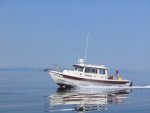Hi All,
Just acquired a 22' C-Dory. Says Hunky Dory on it so I guess it's an early one. Looks like it's been stored outside, uncovered in S E AK for most of its life. I'm looking for advice on any and problem areas to investigate and prioritize. Looks to me like the bottom might be a bit concave? How were these constructed? Foam? Balsa? Might it have some Big Issues and can anyone suggest ways to check?
It has a 90 hp, 4 stroke Merc. Seems kind of slow and heavy; just makes it on step with 3 people on board.... I've never been in one before but thought it would jump on step quicker than it does.
Just acquired a 22' C-Dory. Says Hunky Dory on it so I guess it's an early one. Looks like it's been stored outside, uncovered in S E AK for most of its life. I'm looking for advice on any and problem areas to investigate and prioritize. Looks to me like the bottom might be a bit concave? How were these constructed? Foam? Balsa? Might it have some Big Issues and can anyone suggest ways to check?
It has a 90 hp, 4 stroke Merc. Seems kind of slow and heavy; just makes it on step with 3 people on board.... I've never been in one before but thought it would jump on step quicker than it does.


